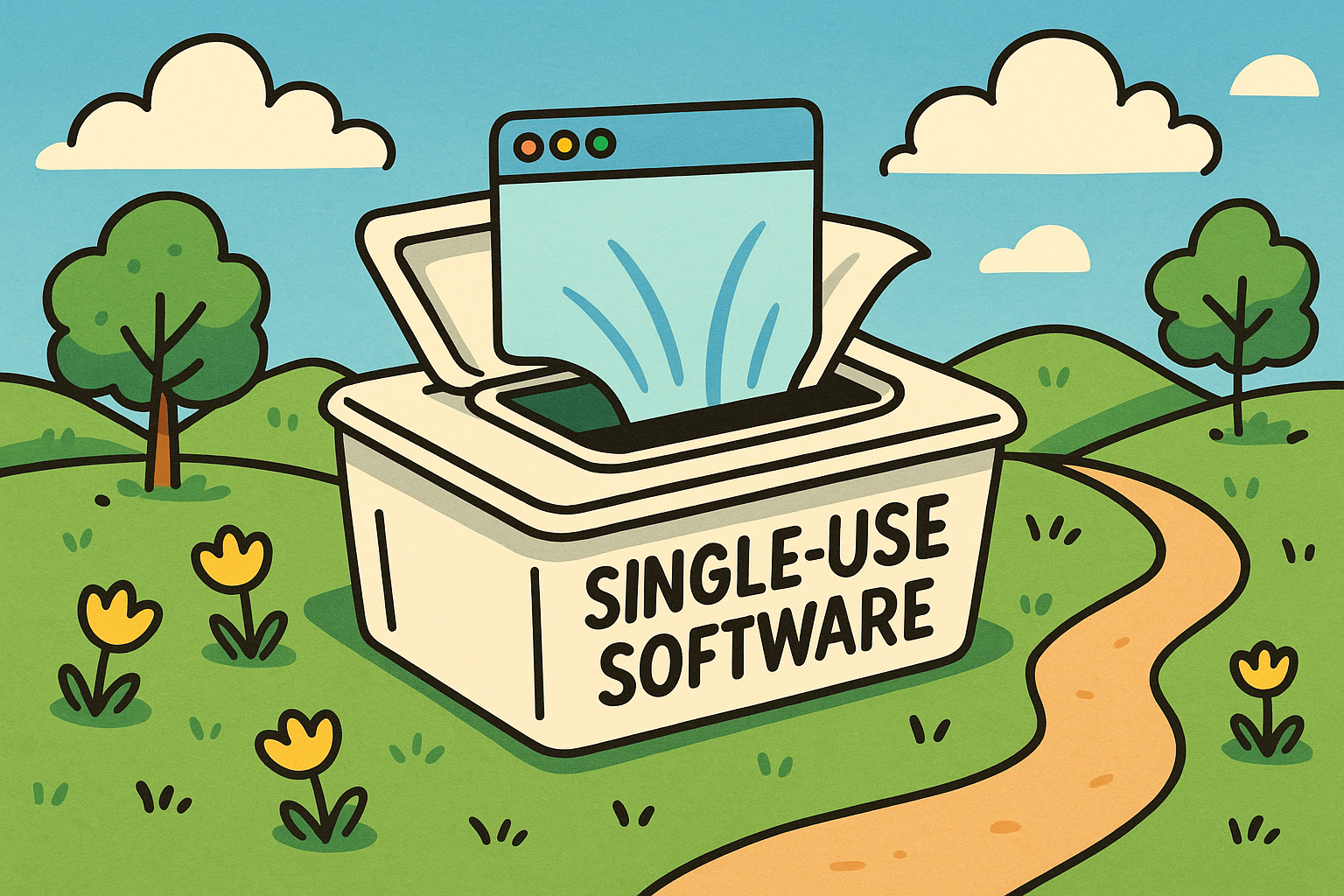
I remember when building software meant hiring a team, setting aside months of runway, and praying your idea would still be relevant by launch day.
Those days are fading fast, and honestly, good riddance.
We’re watching something fascinating unfold right now. Software is becoming less like architecture and more like sketching. Instead of building permanent monuments, we’re creating tools that exist for exactly as long as we need them.
Some people call this “single-use software,” and it’s quietly revolutionizing how businesses operate.
What Are We Talking About?
Think of single-use software like a paper plate at a barbecue. It’s not that it’s cheap or poorly made it just serves its purpose perfectly and doesn’t need to stick around forever. Maybe it’s a custom landing page that runs for two weeks during a product launch.
Or a quick data scraper you build to analyze competitor pricing, then never touch again. Perhaps it’s an internal dashboard your team uses for one client project.
The key insight? Not every piece of software needs to be built to last. Sometimes “good enough for now” is exactly right.
A few things have converged to make this possible, and they’re worth understanding if you’re thinking about starting something new.
First, AI can actually write code now. Not perfectly, not always elegantly, but functionally.
Tools like GPT-5 and Claude have crossed the threshold from “cute demo” to “genuinely useful.” You can describe what you want in plain English and get working code back. It’s not magic it’s just good enough to be transformative.
Second, we’re finally letting go of the idea that every tool needs to scale to a million users. If you need something to work for three days to handle conference registrations, why build it to last three years?
This shift in mindset is subtle but powerful. It means you can move at the speed of thought rather than the speed of development cycles.
Third, the infrastructure is already there. Between APIs, webhooks, and integration platforms, you’re not building from scratch anymore. You’re connecting existing pieces in new ways. It’s like having access to a massive LEGO set where someone else already made all the complicated pieces.
Here’s what’s wild: one person with the right tools can now accomplish what used to require a small team. Not because they’re working harder, but because the leverage has changed so dramatically.
Instead of hiring a designer, you describe what you want to an AI and iterate until it looks right. Instead of bringing on a developer, you explain your logic to GPT-4 and debug together.
Instead of a copywriter, you workshop your messaging with Claude. The quality might not match dedicated specialists, but for most use cases, it’s more than sufficient.
This isn’t about replacing human creativity or expertise. It’s about removing the barriers between having an idea and testing it in the real world. The feedback loop has gotten so tight that you can go from concept to customer in days instead of months.
The traditional startup playbook says to build something robust, scalable, and feature complete. But what if you built something intentionally temporary instead? What if you treated software like a conversation rather than a monument?
This approach changes everything. You can test ten ideas in the time it used to take to perfect one. You can build custom solutions for specific clients without worrying about maintenance. You can create tools that solve today’s problem without overthinking tomorrow’s.
More importantly, you can actually start. The perfectionism that kills so many ventures becomes irrelevant when your goal is to build something useful right now, not something perfect forever.
Every technological shift creates a brief moment where the playing field levels out. We’re in one of those moments now. Big companies are still figuring out their AI policies while individuals are shipping products. Traditional agencies are debating best practices while solopreneurs are landing clients.
But these windows close. First movers establish themselves. Best practices solidify. What seems revolutionary becomes routine. If you’ve been waiting for permission to start something, consider this your sign.
We’re living through a fundamental shift in how software gets made and who gets to make it. The tools are accessible, the barriers are low, and the opportunity is real. You don’t need venture capital or a computer science degree. You need curiosity, persistence, and the willingness to build something imperfect.
The age of single-use software isn’t just about technology. It’s about democratizing the ability to solve problems with code. It’s about making entrepreneurship accessible to people who have ideas but not engineering teams. It’s about accepting that sometimes, temporary solutions are exactly what we need.
If you’ve been sitting on an idea, wondering if you’re technical enough or funded enough or connected enough you probably are. The only question is whether you’ll act on it while the window is still open.
Because in this new world, every day really can be launch day. You just have to decide to begin.
